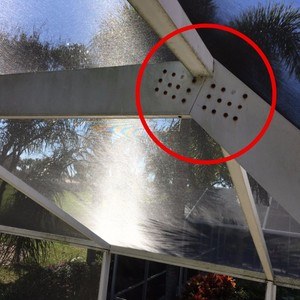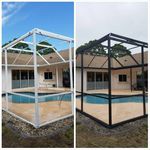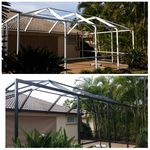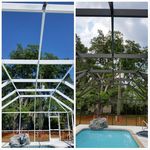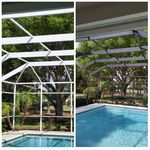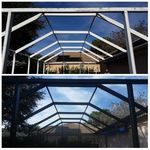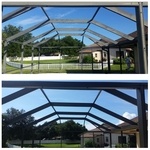The common builders grade screen have a lifespan of just 3 years. It’s rather unfortunate but most pool enclosures in SWFL are built by developers or pool contractors who order the absolute cheapest materials. Here are the common materials used:
- Chinese Artisan Screen. The thinnest of all screen mesh. Loses its original strength very quickly is within 3 years, an afternoon gust of wind is enough to tear the screen.
- Steel Fasteners. In an effort to save a penny most companies use the steel fasteners. They are solid and code compliant when new, but testing shows they loose 75% of their original strength in the first 12 month of Florida conditions. This leaves you with a weak enclosure, no longer rated to the windspeed for which it was designed and leaves rust stains on the framing. Not long after they corrode all the way through and break off, sometimes falling into the pool and breaking the pump equipment.
- Epoxy Paint. It shines well the day it is put it, but quickly fades and sometimes turns a shade of green.
We can’t go back in time and build your pool enclosure higher quality, but rather than going through the process of a full blown replacement which usually costs $15,000+, we can restore it for usually about 1/2 the cost of a new one (more the cost coming later). That’s something most people never think about, because metal is such a difficult surface to paint. But after 200 enclosures repainted in the lasted year alone, we’ve got it down pant.

Here’s How It Works:
Remove The Screen. First thing is first, old screen is removed, cleaned up, and taken away by us.

Upgrade The Fasteners. Next we replace the fasteners. There’s far more fasteners on a pool enclosure than most would expect, usually 2500 individual fasteners on an enclosure 20×40. Instead of putting in the same low quality fastener that was there, we put in a Nylotech fastener which is warrantied for 10 years.
Cover Everything Up. The entire deck and immediate structure (your house) get covered with to ensure the only thing that gets the upcoming paint is the structure.
Prep & Re-Paint It. The surface of the enclosure is prepped as necessary and then painted. Rather than a low grade epoxy paint as commonly used on builders grade enclosures, our paint of choice is an acrylic paint
Re-screen. The final step is a re-screen. Our standard screen is a Phifer 18/14 mesh which has a lifespan of 7-9 years, although 10 year polyester screens with a 10 year warranty are available, along with No See Um Screens.
Once complete, the enclosures look sharp — hardly distinguishable from a new enclosure.
So What Does A Restoration Cost?
As we’ve mentioned above, restorations usually cost about half the price of a new enclosure. It’s impossible to give a ‘catch all’ pricing without knowing the specifics of your structure, but for most of our clients the restoration cost, including a re-screen, fastener replacement, and repaint falls somewhere between $5,000 – $10,000. That said we have done restorations on screen enclosures that cost up to $50,000 although these enclosures would cost $150,000+ new. While it is certainly no small penny the restoration includes the common maintenance items of screen, and fasteners, and then adds on paint for a brand new look.

